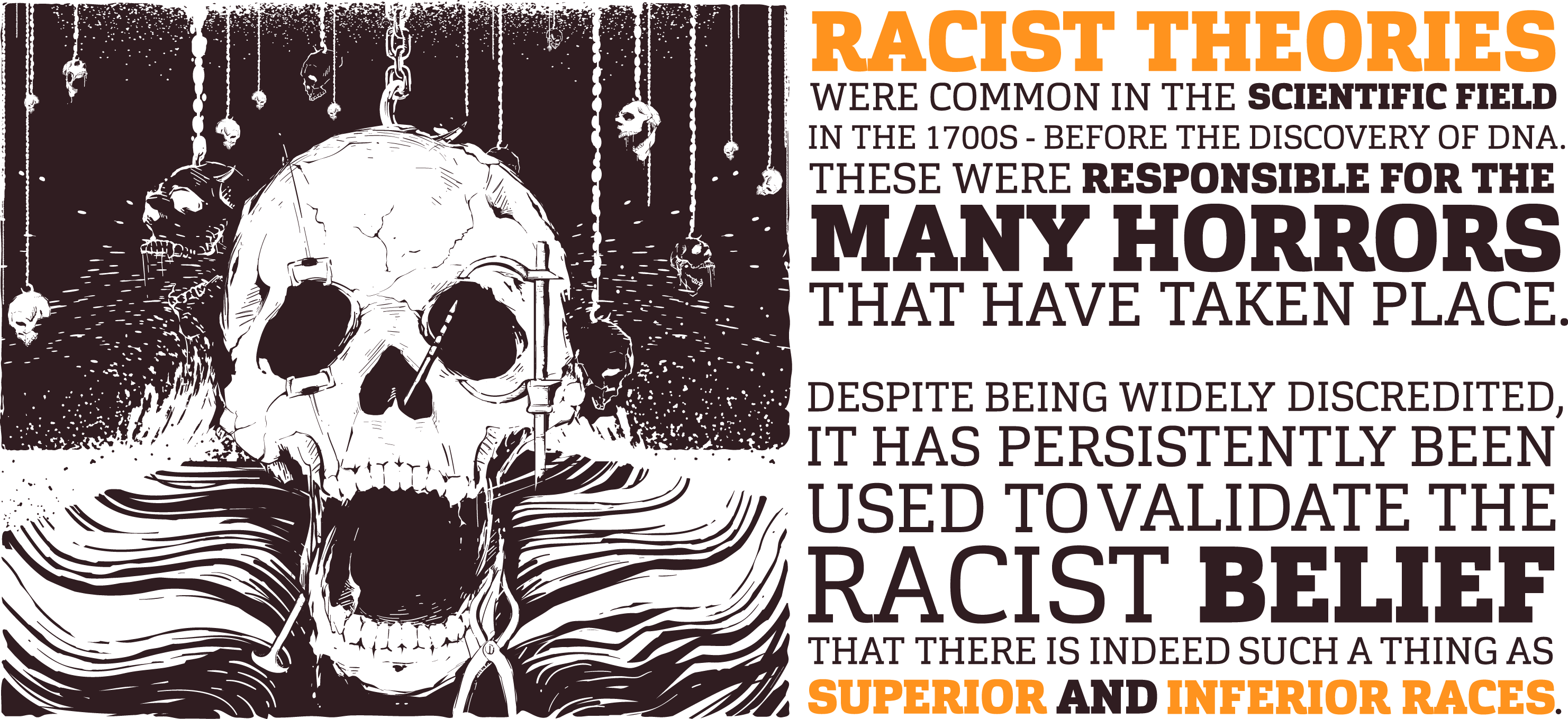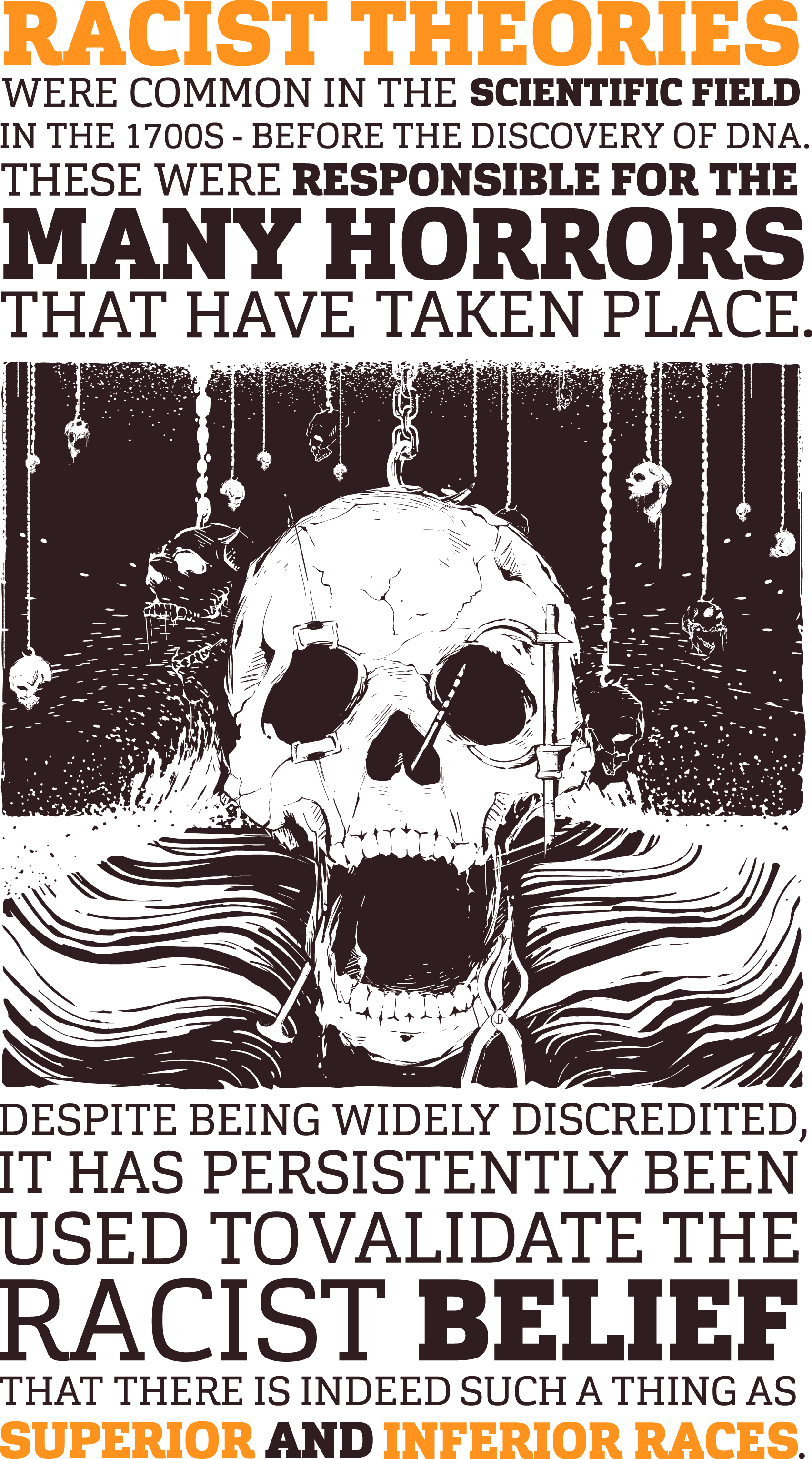
"The story of a little girl, Jihad, facing discrimination because of the name her parents gave her.
Pierce the veil--Unlock the truth--Racism, Nationalism, & Islamophobia, examined through the unbiased lens of scientific inquiry."




The type of racism we see today exists largely because, at various points in history, scientists became determined to divide the world’s people into specific categories.
Belief in and adherence to racist scientific ideas commonly referred to as “scientific racism,” was common beginning in the 1700s up until the end of World War II. Since the second half of the 1900s, however, scientific racism has been increasingly criticized as unsound and out of date. Yet despite being widely discredited, it has persistently been used to validate racist worldviews which are based upon belief in the existence and significance of a hierarchy of racial categories. Such beliefs claim that there is indeed such a thing as superior and inferior races.
In the 1700s, scientist Carl Linnaeus made one of the first attempts at biologically classifying humans. In his work, Systema Natura (1758), Linnaeus used both continental geography and a color scheme to divide humanity into the “white European”, “dark Asiatic”, “red American”, and “black Negro”. Linnaeus also prescribed traits to each race based on his own opinions. Subjective and derogatory characteristics such as "hopeful" Europeans, "sad and rigid" Asiatics, "irascible" American natives, and "calm and lazy" Africans were his traits of choice.
Linnaeus may have been one of the first to classify humans in such a way, but he certainly wasn’t the last. Other attempts at classification were also simplistic and subjective, such as Meiner's (1793) opinion that all nations are derived from two stocks: the handsome, white peoples, which included the Celts, Sarmatians, and Oriental nations; and the ugly, dark peoples, which consisted of all the rest.
The German physiologist Johann Friedrich Blumenbach, frequently called the father of physical anthropology, divided humankind into five “varieties,” one more category than Linnaeus had. In contrast to Linnaeus and Meiner, however, Blumenbach noted that clear lines of distinction could not be drawn between these varieties, as they tended to blend “insensibly” into one another. This idea of traits “blending” into each other hits slightly closer to how scientists think about the human genetic tree today, though it still makes distinctions of race which modern science no longer accepts.
Blumenbach’s five categories included American, Malaysian, Ethiopian, Mongolian, and Caucasian. In an interesting display of racial preference, he chose the term Caucasian to represent the Europeans because a skull from the Caucasus Mountains of Russia was, in his opinion, the most beautiful. These terms were still commonly used by many scientists in the early 1900s, and most continue to be used today as major designations of the world’s populations.
Blumenbach believed in the "degenerative hypothesis" of racial origins. He believed that Adam and Eve were Caucasian inhabitants of Asia and that other races came about by the degeneration of the Caucasian race from environmental factors such as the sun and poor diet. He claimed that Negroid pigmentation was the result of the heat of the tropical sun, while the cold wind caused the tawny color of the Eskimos, and the Chinese were fair-skinned compared to the other Asian stocks because they kept mostly to towns that were protected from environmental factors.
Again, Blumenbach touches on some legitimate biological theories- that skin pigmentation is a response to the environment- but with the wrong reasoning- that all other pigmentations besides Caucasian derived from the single Caucasian skin tone as a result of degeneration. He believed that the proposed “degeneration” could be reversed with proper environmental control and that all contemporary forms of man could revert to the “original” Caucasian race.
In the 1830s and 1840s, one of America’s most prominent scientists was a doctor named Samuel Morton who lived in Philadelphia. As a skull collector, he accepted skulls that were scavenged from battlefields and snatched from catacombs.
Morton, like Blumenbach, believed that humanity could be divided into five races, which he notably believed represented separate acts of creation.
His proposed races also had distinct characteristics, which corresponded to their place in a divinely determined hierarchy. Morton claimed that “whites”, or “Caucasians” – which included people from Europe, Middle East, and North Africa - were the most intelligent. East Asians - or “Mongolian” in Morton’s terms - were one step down. Below that were Southeast Asians, followed by Native Americans. At the bottom were the “Blacks”, or “Ethiopians”. This hierarchical structure was just what scientific racism really needed to propel the concepts of race and racial superiority into the mainstream arena. With such a derogatory hierarchy placing “Blacks” at the very bottom, Morton’s ideas were quickly taken up by those who supported and defended slavery.
Today, Morton is known as the Father of Scientific Racism. So many horrors from the past few centuries can be traced to Morton’s widespread theory that one race is inferior to another. To an uncomfortable degree, we still live with Morton’s legacy: Racial distinctions continue to shape our politics, our neighborhoods, and our senses of self. This is still the case even though modern science’s findings about the existence of race are just the opposite of what Morton argued.
Morton thought he had identified immutable and inherited differences among people, but at the time he was working- long before the discovery of DNA - scientists had no idea how traits were passed on. Researchers who have since been able to view and study people at the genetic level now argue that the whole concept of race is misconceived.
In fact, when scientists set out to assemble the first complete human genome- which they achieved by making a composite from the DNA of several individuals- they deliberately gathered samples from people who self-identified as members of many different ethnicities. Based on findings from the Human Genome Project, which still carries out genetic research today, many scientists now consider race as a social construct, rather than a biological one.
The societies of Europe and European-descent sought to justify not only the institution of slavery, but also its increasingly brutal marginalization of all non-European peoples, slave or free. Science became the vehicle through which they “confirmed” their status of superiority over a large portion of the more melanin-endowed human population. Scientists in Europe and America provided the arguments and evidence to document the inferiority of non-Europeans, which enabled widespread and racially motivated abuses of human rights in the form of slavery, and later, insidious mainstream racism in supposed “free and equal” countries.
Gradually, through scientific advances, it became obvious that human variation was not actually a result of either having or not having certain genes. Instead, we discovered that these differences in appearance corresponded with the inheritance of varying frequencies of the same set of genes shared by all populations of humans.
Dark skin was no longer thanks to a gene that some (“inferior”) people had and other (“superior”) people didn’t. Rather, we all have the exact same genes, which are capable of producing every human trait, and the traits we end up with just depend on how many of which genes we have more or less of. No classification system that separates humans into distinct species, or even subspecies, could hold up under the light of these sciences.
Still, by the end of the 1800s, the idea of a hierarchy of races that elevated some nations and people above others was widely accepted by many in the upper classes of Europe, Great Britain, and the United States. The wealthy and powerful were often arrogant in the belief that their superior station and position was justified and secured by nature. Many people today, due to a lack of information and education about the subject, still genuinely believe that races exist with clear-cut, biological differences between them.



"The story of a little girl, Jihad, facing discrimination because of the name her parents gave her.
Pierce the veil--Unlock the truth--Racism, Nationalism, & Islamophobia, examined through the unbiased lens of scientific inquiry."





